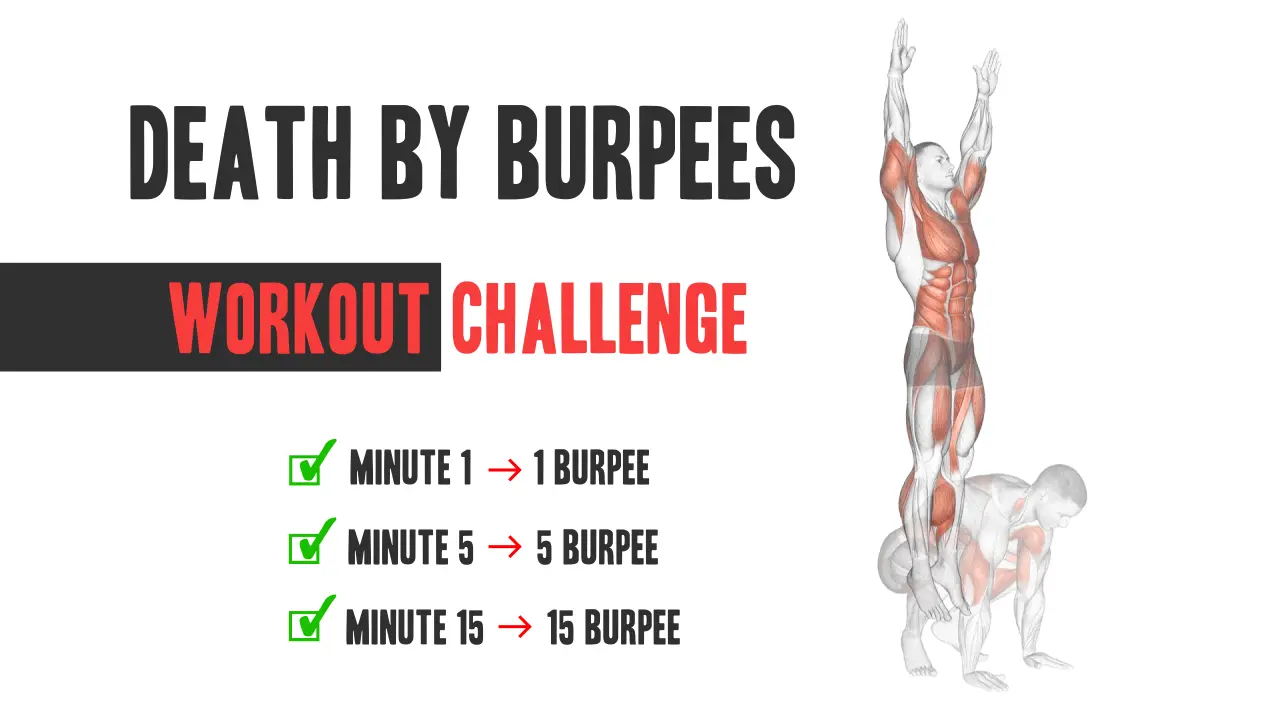Contents
The “Death by Burpees” workout is a popular conditioning and endurance challenge often used in CrossFit and functional training. It follows a simple yet brutal progression format: you start with a low number of burpees in the first minute and increase the number each subsequent minute until you can no longer keep up. Despite its simplicity, this workout tests cardiovascular fitness, muscular endurance, mental grit, and recovery ability all at once.
What is the Death by Burpees Workout?
The structure is straightforward:
- Minute 1: Perform 1 burpee.
- Minute 2: Perform 2 burpees.
- Minute 3: Perform 3 burpees.
- Continue increasing by 1 rep each minute.
- The workout ends when you can’t complete the required burpees within the minute.
This makes it a form of escalating EMOM (Every Minute on the Minute) training, where the workload grows until fatigue forces failure.
How to Perform It
- Set a timer that signals each new minute.
- Begin with 1 burpee in the first minute.
- Rest for the remainder of that minute.
- At the start of minute 2, do 2 burpees, then rest.
- Continue adding one burpee per minute.
- When you cannot finish the required reps within the minute, the workout ends.
Example Progression
- Minute 1 → 1 burpee
- Minute 5 → 5 burpees
- Minute 10 → 10 burpees
- Minute 15 → 15 burpees (usually where many people fail)
Muscles Worked
The burpee is a full-body exercise, and the “Death by Burpees” method amplifies total-body fatigue:

- Chest & Triceps: From the push-up phase
- Shoulders: Stabilization and pushing off the ground
- Quads & Glutes: Squat portion
- Hamstrings: Hip extension
- Core: Stabilization during plank and jumping
- Calves: Jumping at the top
Benefits of the Death by Burpees Workout
1. Cardiovascular Endurance: The continuous pace increases heart rate and challenges aerobic and anaerobic systems.
2. Muscular Endurance: Repeated push-ups, squats, and jumps test muscular fatigue resistance.
3. Mental Toughness: The workout is simple to understand but extremely difficult to complete, making it a mental challenge as much as a physical one.
4. Scalability: Beginners can start with half burpees or cap the workout at 10 minutes, while advanced athletes can push beyond 15–20 minutes.
5. Minimal Equipment Needed: All you need is a timer and bodyweight—making it a perfect travel workout or no-gym challenge.
Programming the Death by Burpees Workout
The workout can be adapted depending on training goals:
- Beginners: Cap at 10 minutes or use no-pushup burpees variation
- Conditioning Athletes: Use as a high-intensity finisher 1–2 times per week.
- CrossFit or Advanced Athletes: Push past 15 minutes to test work capacity.
Integration Example
- Strength Training Day: Do main lifts (squat, bench, deadlift), then finish with “Death by Burpees” for conditioning.
- Cardio Conditioning Day: Use as a standalone workout.
- Circuit Training: Alternate with kettlebell swings, rowing, or push-ups for variety.
Tips for Proper Form
- Keep chest and thighs touching the floor during the push-up phase.
- Land softly when jumping to reduce joint stress.
- Keep core tight to prevent lower back strain.
- Pace yourself early—avoid sprinting through the first few minutes.
Common Mistakes to Avoid
- Poor Push-Up Form: Sagging hips or skipping the push-up altogether.
- Rushing Reps: Leads to sloppy movement and injury risk.
- Not Controlling Breathing: Breathlessness comes quickly if you forget to pace.
- Overestimating Capacity: Many attempt 20+ minutes too soon, leading to burnout.
Sample Death by Burpees Challenge
Beginner Version

- Start with 1 push-up-free burpee per minute, complete in 10 minutes.
Intermediate Version

- Full version: continue until failure (usually 12–15 minutes).
Advanced Version

- Add a Navy Seal Burpee variation.
- Aim for 15+ minutes.
Who Should Try It?
- CrossFit athletes who want to test conditioning.
- Fitness enthusiasts seeking a bodyweight-only challenge.
- Athletes in combat sports or endurance sports who need mental toughness training.
Final Thoughts
The “Death by Burpees” workout is deceptively simple but brutally effective. It’s an escalating EMOM challenge that builds conditioning, endurance, and resilience while requiring no equipment. Whether you use it as a test of grit, a conditioning finisher, or a travel-friendly workout, it can be a valuable addition to your training plan.
If you’re new to this style, start conservatively and aim for steady improvement. For advanced athletes, challenge yourself past the 15–20 minute mark to test both body and mind.



